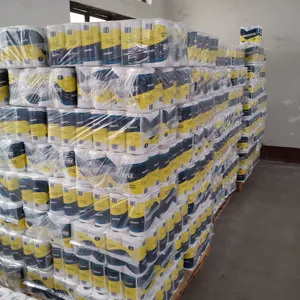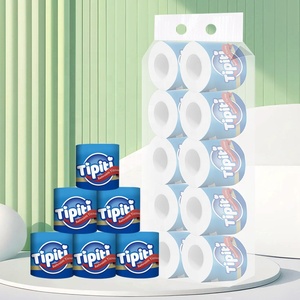
All categories
Featured selections
Trade Assurance
Buyer Central
Help Center
Get the app
Become a supplier

(10763 products available)




















































Toilet rolls come in various types, each serving different preferences and needs in the personal care and household cleaning sector. Manufacturers offer some strong choices to satisfy customers' needs and those prioritizing sustainability, comfort, performance, or even aesthetics.
Among the most widely bought kinds are the reliable and adaptable two-ply toilet rolls. Because they have two layers, they are thicker, softer, and more absorbent than one-ply varieties. For restrooms in domestic and commercial settings, two-ply rolls provide a happy medium between comfort and utility. The production procedure may be slightly more expensive because more sheets are required, but the end result is a better product that satisfies most customers' requirements.
Three-ply toilet paper is excellent for customers who value comfort the most and degradation capability. The additional ply level guarantees superior softness and absorbency, making it perfect for luxury bathrooms in hotels and premium residences. Although it is often more costly than two-ply, three-ply paper is excellent for firms intending to project an image of sophistication. In the green market, one can also locate three-ply rolls constructed from recycled materials.
With growing environmental awareness, the market for green products has expanded. Recycled paper toilet rolls are made from recovered paper, reducing waste levels while still providing a functional product. Usually one- or two-ply, these rolls are excellent for customers who care about the environment but still want their basic toilet paper needs met. They may be marketed to customers who purchase in bulk, like those in large corporations or government institutions.
Single-ply toilet rolls are less expensive and ideal for places that value function more than comfort, such as factories, schools, and public restrooms. These rolls' simpler, thinner design uses less paper per visit and is more economical. Although single-ply rolls are slightly less absorbent and softer than multi-ply options, they are a practical solution that completes the task adequately. Single-ply toilet paper can also appeal to firms who decide to go green because it frequently uses less energy to generate.
Scented toilet paper offers clients something more than the typical experience. Scented rolls come with added fragrances such as lavender, rose, or citrus that conceal odors and offer a spa-like feel, which makes them suitable for high-end hotels or wellness centers. Depending on the aesthetic décor, some scented rolls may also be dyed to match the room. This extra touch improves the user experience and makes one feel more relaxed and comfortable.
When choosing toilet rolls in bulk for personal care and household cleaning, certain considerations should always be noted. Buyers should know the product's quality, absorbency, and softness levels and the cost per unit.
The first and most vital consideration is the toilet roll's quality. Buyers should assess the number of plies, as those with more plies tend to be stronger, softer, and more absorbent. Softness can be evaluated through the material's texture and composition. Using virgin or recycled paper determines the quality of the material. Buying toilet rolls in large quantities can help cut costs as they provide economies of scale.
Another key factor is absorbency, which entails gauging how well the roll can take up liquid without falling apart. High absorbency rolls provide a better user experience while requiring fewer sheets per use. Buyers will also consider the softness of each roll, impacting comfort and experience. Buyers assess this by considering the texture of the sheets and comparing product samples. Strong rolls help avoid embarrassment, while softer options provide higher user satisfaction. Since they can absorb a lot of moisture and ensure better functionality, thick tissue paper designs are a big plus for high quality toilet rolls.
The size and count of the rolls are also important decisions to make. Large rolls and high counts are often suited for public restrooms and wholesale use. For domestic usage, larger rolls are ideal, and fewer will be required. Other factors such as core size and sheet dimensions influence compatibility with various toilet roll dispensers and efficiency in usage. The toilet paper's strength impacts functionality and durability. Stronger toilet rolls also ensure no breakages during use, which can be quite embarrassing. Finally, buyers should evaluate the aesthetic value and environmental impact. While some scented options are valuable, the production process also considers options made from sustainable materials to minimize the environmental impact.
Several trends are based on buyer research and desires, although high-quality toilet rolls are often viewed as a necessary good. People in charge of making purchases and those managing facilities seek goods that fulfill functional requirements while also giving value and enhancing the brand picture.
The first trend in toilet roll production is functionality and sustainability. Customers used to expect toilet rolls made from virgin paper globally now want those made from recycled or sustainable paper. This switch is primarily motivated by the desire to reduce the ecological footprint. As a result, many manufacturers are prioritizing greener materials in production, which helps them stay relevant in an ever-growing green market.
Another significant trend in the toilet rolls industry is toward luxury products. Just a few years back, consumers were content with one- or two-ply rolls. However, with the introduction of hotel-like bathrooms, toilet rolls with more than two plies have become popular. The luxury market is notable for this trend, where thicker, softer rolls that give greater comfort are now a necessity.
Technology, particularly e-commerce, is also changing how toilet rolls are marketed and sold. Businesses are discovering the advantages of direct-to-consumer sales, especially as subscription models become more popular, which ultimately ensures that the product is always in stock. Alibaba.com and other online platforms provide wholesalers with a convenient means to reach large audiences.
Further, companies are also trying to differentiate their products through innovation. From scented toilet paper to those with lotion for extra moisturizing, manufacturers are creating more options to serve more diverse customers. For instance, a niche market has emerged for hypoallergenic toilet rolls to cater to consumers with sensitive skin.
A lot of buyers usually buy toilet rolls in bulk, which makes proper storage essential for upholding quality and ensuring effective inventory management. Some key considerations when storing toilet rolls are the environment, the temperature, and humidity levels.
The first step in storing toilet rolls is choosing the right location. The space storage should be cool, dry, and free from direct sunlight or extreme temperatures. Temperature and humidity can affect paper products like toilet rolls. Excessively high temperatures can dry the paper, making it break up easily during use, while high humidity can cause mold or dampness. Sunlight can also damage some materials, making them fade and affecting the paper quality. Ambient light can also damage the paper; hence, store it in a dark or low-light area.
Another important consideration is ensuring airflow around the rolls to avoid moisture accumulation, which can cause mold or dampness. Space can be efficient and practical when organizing toilet rolls to enhance management and avoid wastage. One can organize them based on the number of plies, the size of the roll, and the style of the paper. This will make it easy to locate and replenish stocks.
To further stock management and efficiency, one should consider using shelving or racks. Toilet rolls stacked on the ground can be cumbersome to manage and lead to breakages. However, with rolling inventory systems in place, older stock is used first, leading to wastage.
Lastly, condition assessments are paramount. The packaging should be frequently examined for any dent, damaged exposed rolls, and signs of mold or insects. All paper goods, including toilet rolls, should be stored in a clean environment free from pollutants, pests, and insects. For this reason, user and stock safety are prioritized, ensuring all products remain in pristine condition until they're finally used.
A1: Virgin wood pulp paper is the preferred material for producing high-quality toilet rolls as it offers great softness, strength, and absorbency. This material breaks up easily in water, so it's ideal for use in toilets.
A2: The number of plies, sheet size, roll count, and whether the paper is recycled all affect the cost of toilet paper. Scented or colored varieties also tend to be pricier because they require more processing and are seen as luxurious.
A3: Manufacturers will indicate if a product is hypoallergenic. Usually, they're made from recycled paper and don't have any added dyes or fragrances.
A4: Packaging choices include simple plastic wrap, bigger packs in cardboard boxes, or even showy printed paper sleeves for rolls to enhance their store display appeal.
A5: Manufacturers often add gentle embossing or printing to high-quality toilet rolls for aesthetics and increased strength and absorbency through better surface contact.